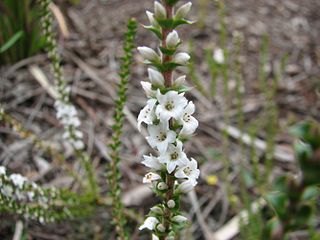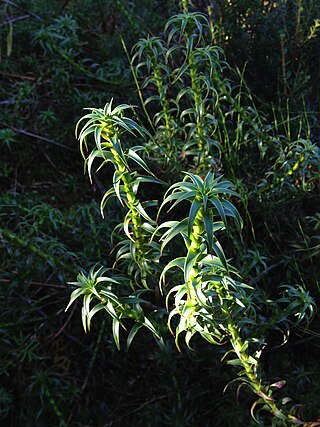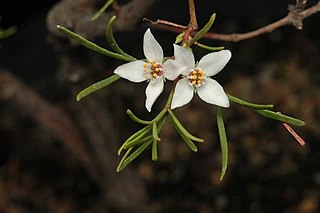
Liparophyllum gunnii, commonly known as alpine marshwort, is a species of aquatic flowering plants in the family Menyanthaceae. It is the type for the genus Liparophyllum. It is a wetland plant having a rhizomatous root structure and alternate linear leaves. Its flowers occur singly, are five-petalled, and white. Flowers bud and open from December to February; fruits form from December through April. L. gunnii is indigenous to Tasmania and New Zealand.

Nothofagus gunnii, the tanglefoot or deciduous beech, is a deciduous shrub or small tree endemic to the highlands of Tasmania, Australia. It was described in 1847 by R.C Gunn N. gunnii is a small woody tree with a shrubby appearance known to grow up to 8 metres (26 ft). It lives only on mountains due to temperature limitations within the Tasmanian maritime climate and mainly grows at altitudes greater than 800 metres (2,600 ft) above sea level. It grows in alpine and sub-alpine regions in the central portions of the island. Though capable of reaching the size of a small tree, it is most common as a thick shrub or woody ground cover, hence its common name of "tanglefoot".

Eucalyptus gunnii, commonly known as cider gum, is a species of large tree in the flowering plant family Myrtaceae. It is endemic to the island of Tasmania, Australia. It has mostly smooth bark, lance-shaped to egg-shaped adult leaves, flower buds in groups of three, white flowers and cylindrical to barrel-shaped fruit.

Thryptomene micrantha, commonly known as ribbed thryptomene, is a species of flowering plant in the family Myrtaceae and is endemic to south-eastern Australia. It is a spreading to erect shrub with egg-shaped leaves, the narrower end towards the base, and white flowers with five petals and five stamens.

Velleia montana, commonly known as mountain velleia, is a flowering plant in the family Goodeniaceae. It is a small, perennial herb with tubular yellow flowers, mainly growing in woodland and sub-alpine grasslands in New South Wales, Victoria and Tasmania.

Scaevola hookeri, commonly known as the creeping fan-flower or alpine fan-flower, is a species of flowering plant in the family Goodeniaceae. It has white or blue flowers with a yellow throat and grows in eastern Australia.

Eucalyptus risdonii, commonly known as the Risdon peppermint, is a species of small tree that is endemic to a small area in southern Tasmania. It has smooth bark, a crown composed mostly of sessile, glaucous, egg-shaped juvenile leaves arranged in opposite pairs. The flower buds are arranged in groups of between nine and fifteen and the fruit are cup-shaped, conical or hemispherical.

Epacris gunnii is a species of flowering plant in the family Ericaceae and is endemic to south-eastern Australia. It is an erect shrub with hairy branchlets, concave, sharply-pointed, broadly egg-shaped leaves, and tube-shaped, white flowers arranged along the stems.

Muehlenbeckia axillaris is a low evergreen shrub, forming wiry mats up to about 1 metre in diameter, native to New Zealand, and the Australian states of Tasmania, New South Wales and Victoria. It has thin, red-brown stems, with glossy squarish to roundish leaves that are less than 1 cm (0.39 in) in diameter and 2–4 mm (0.079–0.157 in) thick. Flowers are inconspicuous, yellowish-white, 4–8 mm (0.16–0.31 in) in diameter, and borne in groups of up to three in the axils. The fruit is black, shiny, and up to 3.5 mm (0.14 in) long, produced in late summer to fall.

Olearia floribunda, commonly known as heath daisy-bush, is a species of flowering plant in the family Asteraceae and is endemic to south-eastern Australia. It is an upright, spreading shrub with egg-shaped leaves and white and yellow or mauve, daisy-like inflorescences.

Persoonia gunnii is a species of flowering plant in the family Proteaceae and is endemic to Tasmania. It is an erect shrub with young branchlets that are hairy at first, spatula-shaped to egg-shaped leaves with the narrower end towards the base, and white to cream-coloured flowers.
Asperula pusilla, commonly known as alpine woodruff, is a species of flowering plant in the family Rubiaceae. It is a perennial herb that is endemic to Australia.

Richea gunnii, the bog candleheath or Gunns richea, is an endemic Tasmanian angiosperm. It is a dicot of the family Ericaceae and is found in Central, Western and North-east Tasmania.

Trochocarpa gunnii, commonly known as sweet-scented trochocarpa or fragrant purpleberry, is a common rainforest understorey shrub from the plant family Ericaceae endemic to Tasmania.

Genoplesium nudiscapum, commonly known as the bare midge orchid, is a species of small terrestrial orchid endemic to Tasmania. It has a single thin leaf fused to the flowering stem and up to twenty small, green and reddish-brown flowers. It was thought to be extinct, since it had not been seen since 1852 but was rediscovered in 2008. The species has also been described as occurring on continental Australia. The species is known as Corunastylis nudiscapa in Tasmania.

Boronia gunnii, commonly known as Gunn's boronia or Cataract Gorge boronia is a plant in the citrus family Rutaceae and is endemic to Tasmania. It is an erect shrub with compound leaves and pink or white, four-petalled flowers.

Brachyscome decipiens, commonly known as field daisy, is a perennial herb in the family Asteraceae and is endemic to Australia. It is a small herb with white or pale blue flowers.

Asperula conferta is a species of flowering plant in the family Rubiaceae. It is Australian endemic distributed across Queensland, New South Wales, Victoria, Tasmania, South Australia and the Northern Territory.
Asperula scoparia is a species of flowering plant in the family Rubiaceae. It was first described in 1847 and is endemic to Tasmania, Victoria and New South Wales in Australia.

Philotheca virgata, commonly known as Tasmanian wax-flower, is a species of flowering plant in the family Rutaceae and is endemic to south-eastern Australia. It is a slender, erect shrub with wedge-shaped to oblong leaves and white or pale pink flowers at the ends of branchlets. It is the only philotheca with four sepals and petals.


















